Table of Contents
Lakhmir Singh Physics Solutions
Get Lakhmir Singh Physics Solutions for Class 10 Physics in Infinity Learn for free.
The Human Eyes And The Colorful World
Question 1:
What kind of lens is present in the human eye ?
Solution :
Convex lens
Question 2:
Name two parts of the eye which refract light rays (or bend light rays)
Solution :
The cornea and eye-lens are two elements of the eye that refract light rays.
Question 3:
Name the part of the eye :
(a) which controls the amount of light entering the eye.
(b) on which the image is formed.
(c) which changes the focal length of eye-lens.
Solution :
(a) Iris
(b) Retina
(c) Ciliary muscles
Question 4:
What is the name of :
(a) the curved, transparent front surface of the eye ?
(b) the light-sensitive layer in the eye ?
Solution :
(a) Cornea
(b) Retina
Question 5:
Where is the image formed in a human eye ?
Solution :
At retina
Question 6:
What is the function of the lens in the human eye ?
Solution :
To focus light on the retina, the eye lens alters its shape and thickness.
Question 7:
What job does the pupil of the eye do ?
Solution :
The intensity of light around the eye causes the pupil to enlarge or shrink.
Question 8:
Flow does the eye adjust to take account of an increase in brightness ?
Solution :
The pupil of our eye contracts.
Question 9:
Name that part of the eye which is equivalent to the photographic film in a camera.
Solution :
Retina
Question 10:
Name the part of the retina which is insensitive to light.
Solution :
Blind spot
Question 11:
Which part of the eye contains cells which are sensitive to light ?
Solution :
Retina
Question 12:
Name two types of cells in the retina of an eye which respond to light.
Solution :
Rods and cones
Question 13:
Out of rods and cones in the retina of your eye :
(a) which detect colour ?
(b) which work in dim light ?
Solution :
(a) Cones
(b) Rods
Question 14:
State whether the following statement is true or false :
The image formed on our retina is upside-down
Solution :
True
Question 15:
What is the principal function of the eye-lens ?
Solution :
The principal function of the eye-lens is to focus light on to the retina.
Question 16:
Where does the greatest degree of refraction of light occur in the eye ?
Solution :
At cornea
Question 17:
What changes the shape of lens in the eye ?
Solution :
Ciliary muscles
Question 18:
What do the ciliary muscles do when you are focusing on a nearby object ?
Solution :
The ciliary muscles thicken the lens of the eyes (more converging).
Question 19:
What is the least distance of distinct vision for a normal human eye ?
Solution :
A normal human eye’s minimum distinct vision distance is roughly 25cm.
Question 20:
What is the :
(a) far point of a normal human eye ?
(b) near point of a normal human eye ?
Solution :
(a) A normal human eye’s far point is infinity.
(b) A normal human eye’s near point is 25cm away from the eye.
Question 21:
What is the range of vision of a normal human eye ?
Solution :
A normal human eye’s vision ranges from infinity to around 25cm.
Question 22:
Name the part of our eyes which helps us to focus near and distant objects in quick succession.
Solution :
Ciliary muscles
Question 23:
Define the term “power of accommodation” of human eye
Solution :
The ability of an eye to focus the distant objects as well as the nearby objects on the retina by changing the focal length of its lens is called the power of accommodation.
Question 24:
Give the scientific names of the following parts of the eye :
(a) carries signals from an eye to the brain.
(b) muscles which change the shape of the eye-lens.
(c) a hole in the middle of the iris.
(d) a clear window at the front of the eye.
(e) changes shape to focus a picture on the retina.
Solution :
(a) Optic nerve
(b) Ciliary muscles
(c) Pupil
(d) Cornea
(e) Eye lens
Question 25:
Fill in the following blanks with suitable words :
(a) Most of the refraction of light rays entering the eye occurs at the outer surface of the………….
(b) The part of eye sensitive to light is…………….
(c) The part of eye which alters the size of the pupil is………….
(d) When light is dim, the pupil becomes…………
(e) The iris controls the amount of…………… entering the eye.
(f) The ciliary muscles control the shape of the…………..
(g) To bring light from a distant object to a focus on the retina of the eye, the convex eye-lens needs to be made……
(h) To bring light from a near object to a focus on the retina of the eye, the convex eye-lens needs to be made……
Solution :
(a) cornea
(b) retina
(c) iris
(d) large
(e) light
(f) eye-lens
(g) thinner
(h) thicker
Question 26:
Why is a normal eye not able to see clearly the objects placed closer than 25 cm ?
Solution :
Because all of the eye’s accommodation capability is exhausted at a distance of 25 cm, the normal eye is unable to perceive well objects put closer than 25 cm. When the object is put at a distance of 25 cm from the eye, the eye’s maximum accommodation is obtained. After that, the ciliary muscles are unable to thicken the eye lens.
Question 27:
What changes take place in the shape of eye-lens :
(a) when the eye is focused on a near object ?
(b) when the eye is focused on a distant object ?
Solution :
(a) Eye-lens becomes thicker.
(b) Eye-lens become thinner.
Question 28:
The eyes of a person are focused
- on a nearby object, and
- on a distant object, turn by turn. In which case :
(a) the focal length of eye-lens will be the maximum ?
(b) the converging power of eye-lens will be the maximum ?
Solution :
(a) When the eye is focused on a distant object.
(b) When the eye is focused on a nearby object.
Question 29:
What change is made in the eye to enable it to focus on objects situated at different distances ? Illustrate your answer with the help of diagrams.
Solution :
The ciliary muscles of the eye relax completely to focus on distant objects, pulling the suspensory ligaments linked to the eye-lens taut. As a result, the eye-lens strains, and the eye-lens becomes thin.
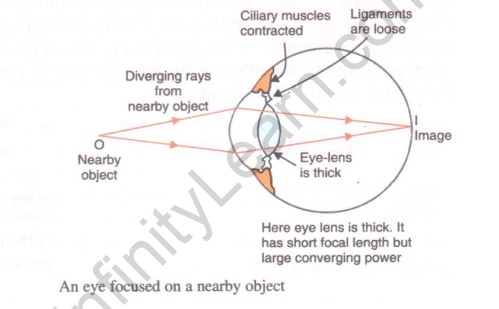
The ciliary muscles of the eyes contract to focus on close objects, loosening the suspensory ligaments. After that, the ligaments stop pushing on the eye-lens. The eye-lens bulges and thickens due to its inherent flexibility.
Question 30:
How is the amount of light entering the eye controlled ?
Solution :
The iris regulates the amount of light that enters the eye. It automatically adjusts the pupil size based on the amount of light received by the eye. The iris contracts the pupil and lowers the amount of light entering the eye when the amount of light received by the eye is large. When the amount of light reaching the eye is insufficient, the iris dilates the pupil to allow more light to enter.
Question 31:
What happens to the eye when you enter a darkened cinema hall from bright sunshine ? Give reason for your answer.
Solution :
When we walk into a darkened cinema hall after being in strong sunlight, we can’t see much properly at first. Our vision improves after a short period of time. This is because our pupil is narrow under bright sunlight, and when we enter a darkened place, very little light enters our eye, causing us to be unable to see well. After a while, our pupil grows, allowing more light to enter our eye and allowing us to see clearly.
Question 32:
Why does it take some time to see objects in a dim room when you enter the room from bright sunshine outside ?
Solution :
When we enter a dim room from bright sunlight outdoors, it takes some time for the small pupil of our eye to enlarge and allow more light to enter our eye, allowing us to see well.
Question 33:
A person walking in a dark corridor enters into a brightly lit room :
(a) State the effect on the pupil of the eye.
(b) How does this affect the amount of light entering the eye ?
Solution :
(a) Pupil becomes smaller.
(b) The amount of light entering the eye is reduced.
Question 34:
Ciliary muscles of human eye can contract or relax. How does it help in the normal functioning of the eye ?
Solution :
When the eye is looking at a far object, the ciliary muscles relax and the eye lens thins; when the eye is looking at a close object, the ciliary muscles contract and the eye lens thickens. As a result, ciliary muscles assist in the normal functioning of the eye by adjusting the thickness of the eye lens during focusing.
Question 35:
Describe and explain, how a normal eye can see objects lying at various distances clearly.
Solution :
The ciliary muscles of the eye relax completely to focus on distant objects, pulling the suspensory ligaments linked to the eye-lens taut. As a result, the eye-lens strains, and the eye-lens becomes thin. This narrow eye-lens has a wide focal length and a low converging power, allowing it to converge parallel light rays from a distant object to generate an image on the retina.
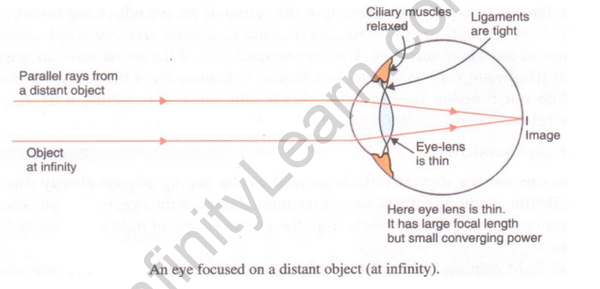
The ciliary muscles of the eyes contract to focus on close objects, loosening the suspensory ligaments. After that, the ligaments stop pushing on the eye-lens. The eye-lens bulges and thickens due to its inherent flexibility. This thick eye-lens has a short focal length and a high convergence power, allowing diverging rays from a close object to converge and produce an image on the retina.
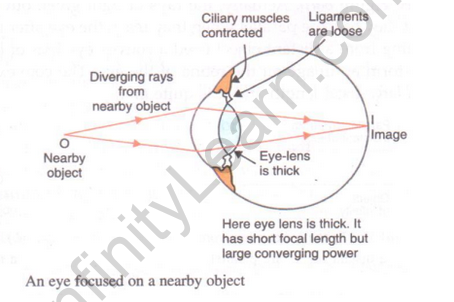
Question 36:
There are two types of light-sensitive cells in the human eye :
(a) Where are they found ?
(b) What is each type called ?
(c) To what is each type of cell sensitive ?
Solution :
(a) The retina has two types of light-sensitive cells.
(a) They’re referred to as rods and cones.
(c) Cones are sensitive to bright light and colours, while rods are sensitive to dim light.
Question 37:
What are rods and cones in the retina of an eye ? Why is our night vision relatively poor compared to the night vision of an
owl ?
Solution :
Rods are rod-shaped cells that are sensitive to dim light and are found in the retina of the eye.
The cone-shaped cells in the retina of an eye that are sensitive to strong light are known as cones.
Due to the existence of a reduced number of rod cells in our retinas, our night vision is inferior to that of an owl.
Question 38:
(a) How does the convex eye-lens differ from the ordinary convex lens made of glass ?
(b) List, in order, the parts of the eye through which light passes to reach the retina.
Solution :
(a) The ciliary muscles can change the focal length of a convex eye-lens, while the focal length of a regular convex lens constructed of glass is fixed.
(b) Cornea, pupil, eye-lens, retina.
Question 39:
(a) What happens to the size of pupil of our eye
- in dim light
- in bright light ?
(b) Name the cells on the retina of an eye which are sensitive to
- bright light
- dim light
- sensation of colour.
Solution :
(a)
- In dim light, pupil becomes large.
- in bright light, puoil becomes small.
(b)
- Cones
- Rods
- Cones
Question 40:
(a) Draw a simple diagram of the human eye and label clearly the cornea, iris, pupil, ciliary muscles, eye-lens, retina, optic nerve and blind spot.
(b) Describe the working of the human eye with the help of the above diagram.
(c) How does the eye adjust itself to deal with light of varying intensity ?
Solution :
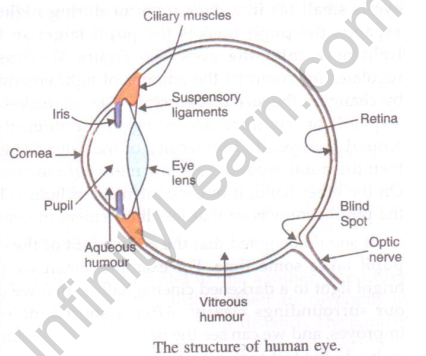
(b) Working of the human eye
The light beams from the object in front of the eye pass via the cornea, the pupil, and land on the eye lens. Because the lens of the eye is convex, light rays converge and generate a real and inverted image of the object on the retina. The optic nerve transmits the image created on the retina to the brain, resulting in the experience of vision.
(c) With the help of the iris, the eye adapts itself to deal with light of varying intensity. The iris adjusts the size of the pupil automatically in response to the amount of light received by the eye. The iris contracts the pupil and lowers the amount of light entering the eye when the intensity of light is high. If the light intensity is low, the iris opens the pupil to allow more light to enter the eyes.
Question 41:
(a) Explain the functions of the following parts of the eye :
(a) cornea (b) iris (c) pupil (d) ciliary muscles (e) eye-lens(f) retina (g) optic nerve
(b) If you walk from a dark room into sunlight and back again into dark room, how would your pupils alter in size ? What makes this happen ?
(c) Explain why, we cannot see our seats first when we enter a darkened cinema hall from bright light but gradually they become visible.
Solution :
(a) a. Cornea: It is the front part of the eye. The light coming from objects enters the eye through cornea.
b. Iris: It controls the amount of light entering the eye.
c. Pupil: It controls the illumination in the eye.
d. Ciliary muscles: The focal length of the eye-lens can be changed by changing its shape by the action of ciliary muscles.
e. Eye-lens: It focuses light on to the retina.
f. Retina: It is a delicate membrane having a large number of light sensitive cells called ‘rods’ and ‘cones’ which respond to the intensity of light and colour of objects respectively.
g. Optic nerve: It conveyes the image formed on the retina to the brain.
(a) The pupil of the eye contracts when we walk from a dark environment to sunlight. The pupil of the eye increases when you return to the dark room.
(c) When we walk into a darkened cinema auditorium after being in strong sunlight, we can’t see our seats at first, but they gradually become apparent. This is because our pupil is narrow under bright sunlight, and when we enter a darkened place, very little light enters our eye, causing us to be unable to see well. After a while, our pupil grows, allowing more light to enter our eye and allowing us to see clearly.
Question 53:
he descriptions of five kinds of images are given below :
(a) diminished and virtual
(b) enlarged and real
(c) enlarged and erect
(d) real and inverted
(e) virtual and the same size
Which one of these describes the image formed :
- on the retina of the eye ?
- by a magnifying glass ?
- by a convex driving mirror on a car ?
- by a plane mirror ?
- on the screen of a slide projector ?
Solution :
- d
- c
- a
- e
- b
Question 54:
What shape are your eye-lenses :
(a) when you look at your hand ?
(b) when you look at a distant tree ?
Solution :
(a) Thick
(b) Thin
Question 55:
Suggest how your irises help to protect the retinas of your eyes from damage by bright light.
Solution :
By altering the size of the pupil in response to the amount of light received by the eye, irises help to protect the retinas of our eyes from damage caused by strong light.
Question 56:
(a) Which parts of the eye cause rays of light to converge on the retina ?
(b) Which part causes the greatest convergence ?
(c) Which part brings the image into sharp focus on the retina ? How does it do this ?
Solution :
(a) Cornea and eye-lens
(b) Cornea
(c) Eye lens
By changing its thickness and hence conversing power.
Question 57:
An object is moved closer to an eye. What changes must take place in the eye in order to keep the image in sharp focus ?
Solution :
The shape of the eyes-lens should be changed by ciliary muscles to thicken it and increase its converging power.
Question 58:
Why does the eye-lens not have to do all the work of converging incoming light rays ?
Solution :
Because the cornea of the eye also converges light rays entering the eye, the eye lens does not have to undertake all of the work of converging incoming light rays.
Question 59:
Explain why, when it is getting dark at night, it is impossible to make out the colour of cars on the road.
Solution :
In weak light, the color-detecting cells in the retina of the eye, known as ‘cones,’ do not perform well.
Question 60:
Nocturnal animals (animals which sleep during the day and come out at night) tend to have wide pupils and lot of rods in their retinas. Suggest reasons for this.
Solution :
During the night, wide pupils allow more light to penetrate the eye.
Rod cells in the retina are sensitive to weak light and hence aid with night vision.
Question 1:
Name one of the common defects of vision and the type of lens used to remove it.
Solution :
Defect: Myopia; Corrected by using concave lens.
Question 2:
Name the defect of vision in a person :
(a) whose near point is more than 25 cm away.
(b) whose far point is less than infinity
Solution :
(a) Hypermetropia
(b) Myopia
Question 3:
Which defect of vision can be rectified :
(a) by using a concave lens ?
(b) by using a convex lens ?
Solution :
(a) Myopia
(b) Hypermetropia
Question 4:
What type of lens is used to correct
(a) hypermetropia
(b) myopia ?
Solution :
(a) Convex lens
(b) Concave lens
Question 5:
What is the other name for
(a) myopia (b) hypermetropia ?
Solution :
(a) Near Sightedness
(b) Far Sightedness
Question 6:
What is the scientific name of
(a) short-sightedness, and
(b) long-sightedness ?
Solution :
(a) Myopia
(b) Hypermetropia
Question 7:
What kind of lens is used to correct (a) short-sightedness (b) long-sightedness ?
Solution :
(a) Concave lens
(b) Convex lens
Question 8:
State whether the following statement is true or false :
Short-sightedness can be cured by using a concave lens.
Solution :
True
Question 9:
Name the defect of vision in which the eye-lens loses its power of accommodation due to old age.
Solution :
Presbyopia
Question 10:
Name the defect of vision which makes the eye-lens cloudy resulting in blurred vision.
Solution :
Cataract
Question 11:
What is the other name of old age hypermetropia ?
Solution :
Presbyopia
Question 12:
Name any two defects of vision which can be corrected by using spectacles.
Solution :
(a) Myopia
(b) Hypermetropia
Question 13:
Name one defect of vision (or eye) which cannot be corrected by any type of spectacle lenses.
Solution :
Cataract
Question 14:
Name the body part with which the terms myopia and hypermetropia are connected.
Solution :
Eye
Question 15:
What is the far point of a person suffering from myopia (or short-sightedness) ?
Solution :
Less than infinity.
Question 16:
Where is the near point of a person suffering from hypermetropia (or long-sightedness) ?
Solution :
The near point of a person suffering from hypermetropia is farther away from the normal near point (25 cm).
Question 17:
Your friend can read a book perfectly well but cannot read the writing on blackboard unless she sits on the front row in class.
(a) Is she short-sighted or long-sighted ?
(b) What type of lenses-converging or diverging-would an optician prescribe for her ?
Solution :
(a) Short-sighted
(b) Diverging lenses
Question 18:
A man can read the number of a distant bus clearly but he finds difficulty in reading a book.A man can read the number of a distant bus clearly but he finds difficulty in reading a book.
(a) From which defect of the eye is he suffering ?
(b) What type of spectacle lens should he use to correct the defect ?
Solution :
(a) Hypermetropia (Long Sightedness)
(b) Convex lens
Question 19:
A student sitting in the last row of the class-room is not able to read clearly the writing on the blackboard.
(a) Name the type of defect he is suffering from.
(b) How can this defect by corrected ?
Solution :
(a) Myopia (Short – Sightedness)
(b) Concave lens
Question 20:
Complete the following sentences :
(a) A short-sighted person cannot see ……….. objects clearly. Short-sightedness can be corrected by using
……… lenses.
(b) A long-sighted person cannot see…………. objects clearly. Long-sightedness can be corrected by using
………. lenses.
Solution :
(a) distant, concave
(b) nearby, convex
Question 21:
What are the two most common defects of vision (or defects of eye) ? How are they corrected ?
Solution :
Myopia and hypermetropia are the two most prevalent vision problems. A concave lens can be used to correct myopia, while a convex lens can be used to correct hypermetropia.
Question 22:
Differentiate between myopia and hypermetropia. What type of spectacles should be worn by a person having the defects of myopia as well as hypermetropia ? How does it help ?
Solution :
Myopia is a condition in which a person can see adjacent objects clearly but not distant objects. Hypermetropia is a condition in which a person can see distant items clearly but not nearer objects.
A person with myopia or hypermetropia should wear spectacles with bifocal lenses, which have a concave upper part and a convex lower part.
Myopia is corrected in the top section, while hypermetropia is corrected in the bottom part.
Question 23:
Name the defect of vision which can be corrected by a converging lens. Show dearly by a ray diagram how the lens corrects the defect.
Solution :
A converging lens can be used to rectify hypermetropia.
The following diagram illustrates hypermetropia correction:
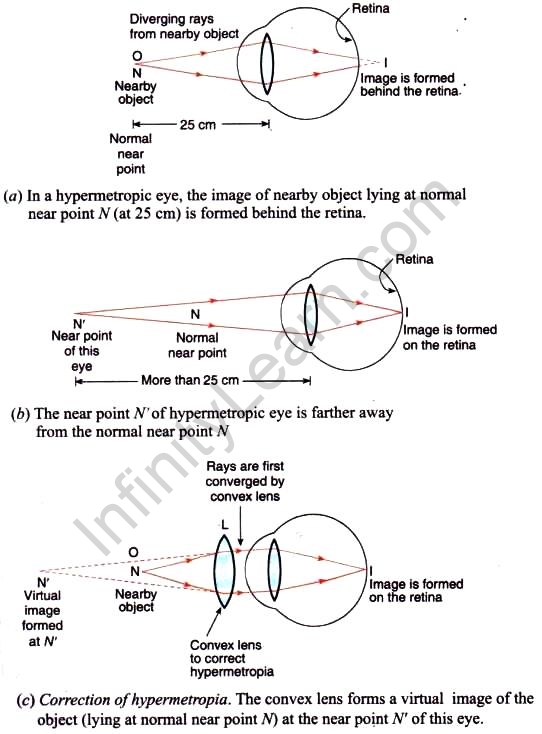
Question 24:
Name the defect of vision which can be corrected by a diverging lens. Show clearly by a ray diagram how the lens corrects the defect.
Solution :
Hypermetropia can be corrected using a converging lens.
Correction for hypermetropia is depicted in the diagram below:
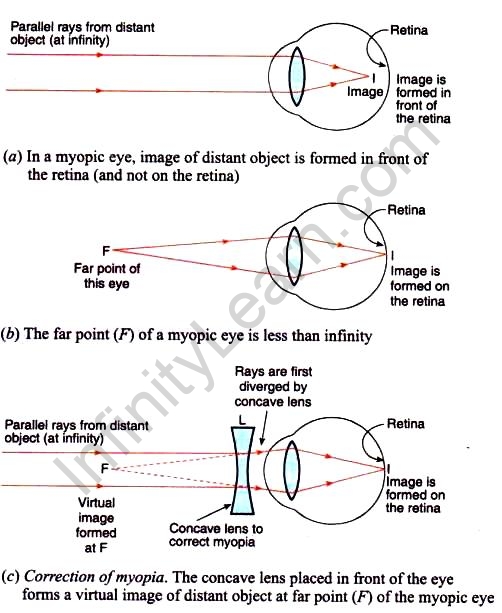
Question 25:
Explain with the help of labelled ray diagram, the defect of vision called myopia and how it is corrected by a lens.
Solution :
Myopia, often known as short sightedness, is a vision problem in which a person is unable to view distant things clearly (though he can see the nearby objects clearly). A concave lens can be used to treat this vision problem.
The following diagrams show a myopic eye and how to correct it.
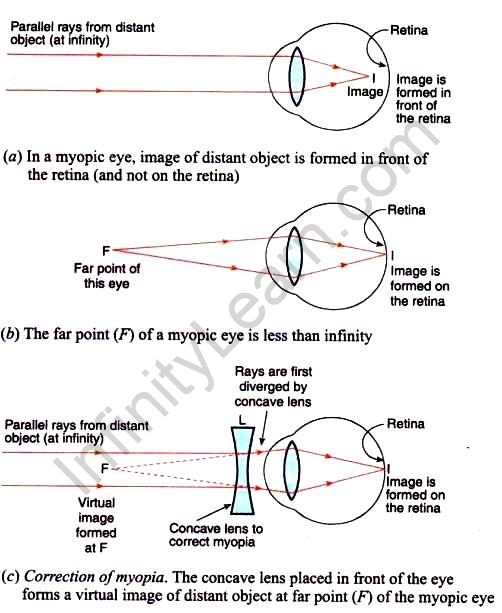
Question 26:
Explain with the help of labelled ray-diagram, the defect of vision called hypermetropia, and how it is corrected by a lens.
Solution :
Hypermetropia (sometimes known as long-sightedness) is a vision problem in which a person can’t see adjacent objects clearly (though he can see the distant object clearly). A convex lens can be used to treat this vision problem.
The following diagrams show a hypermetropic eye and its correction:
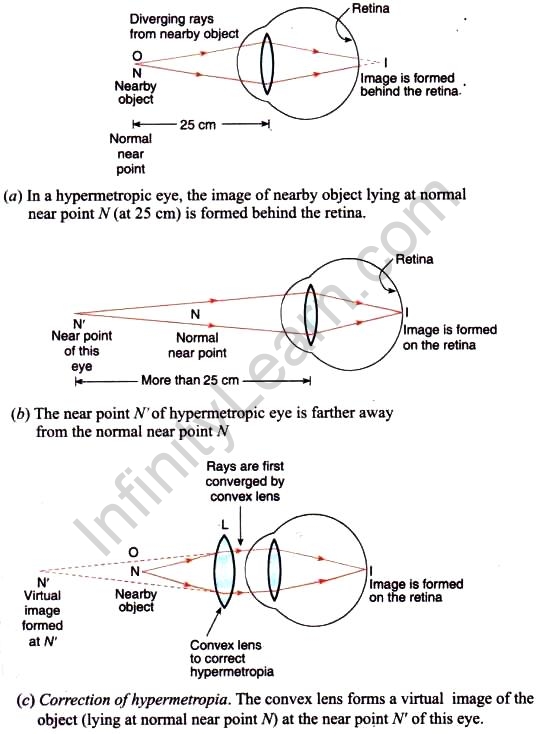
Question 27:
A person suffering from the eye-defect myopia (short-sightedness) can see clearly only up to a distance of 2 metres. What is the nature and power of lens required to rectify this defect ?
Solution :
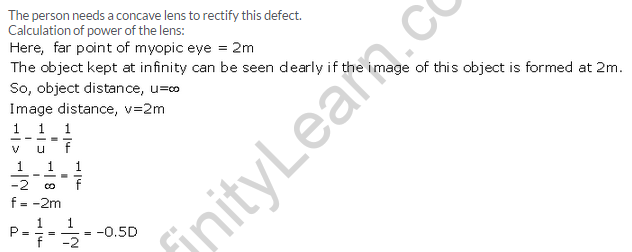
Question 28:
The near-point of a person suffering from hypermetropia is at 50 cm from his eye. What is the nature and power of the lens needed to correct this defect ? (Assume that the near-point of the normal eye is 25 cm).
Solution :
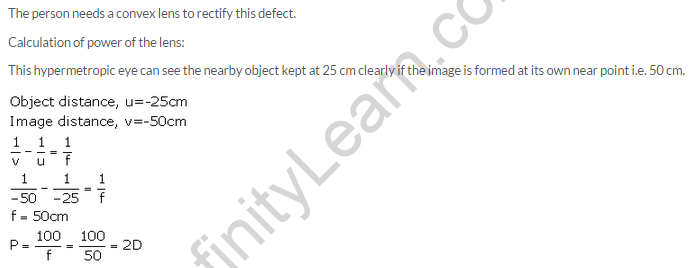
Question 29:
A person needs a lens of power, – 5.5 dioptres for correcting his distant vision. For correcting his near vision, he needs a lens of power, +1.5 dioptres. What is the focal length of the lens required for correcting
- distant vision, and
- near vision ?
Solution :
- For distant vision:
P = -5.5D
P = 1/f
f = 1/P = 1/(-5.5) = -0.1818 m = -18.18cm - For Near Vision:
P = 1.5D
P = 1/f
f = 1/P = 1/1.5 = 0.6666 = 66.66 cm
Question 30:
What is presbyopia ? Write two causes of this defect. Name the type of lens which can be used to correct presbyopia.
Solution :
Presbyopia is a visual problem in which an elderly person loses their ability to view nearer objects clearly due to a decrease of ocular accommodation power.
Causes: The ciliary muscles gradually weaken, and the flexibility of the eye lens decreases.
Convex lenses can be used to correct it.
Question 31:
When is a person said to have developed cataract in his eye ? How is the vision of a person having cataract restored ?
Solution :
When the eye lens becomes increasingly clouded, resulting in blurred vision, a person is said to have developed cataract.
The eyesight of a person with a cataract can be restored once surgery is performed on the affected eye. Surgically, the opaque lens is removed from the eye, and a new artificial lens is implanted in its stead.
Question 32:
Fill in the following blanks with suitable words :
A person is short-sighted if his eyeball is too……………. Spectacles with a………… lens are needed. A person
is long-sighted if his eyeball is too……………. Spectacles with a …………. lens are needed. These focus light
rays exactly on to the………..
Solution :
long, concave, short, convex, retina
Question 33:
(a) What is short-sightedness ? State the two causes of short-sightedness (or myopia). With the help of ray
diagrams, show :
- the eye-defect short-sightedness.
- correction of short-sightedness by using a lens.
(b) A person having short-sight cannot see objects clearly beyond a distance of 1.5 m. What would be the nature and power of the corrective lens to restore proper vision ?
Solution :
(a) Short Sightedness is a vision deficiency that causes a person to be able to see nearby items clearly but not distant objects.
Causes:
1. An excessive curvature of the lens of the eye
2. An increase in the length of the eyeball
Ray diagram for:
(i) eye-defect short-sightedness
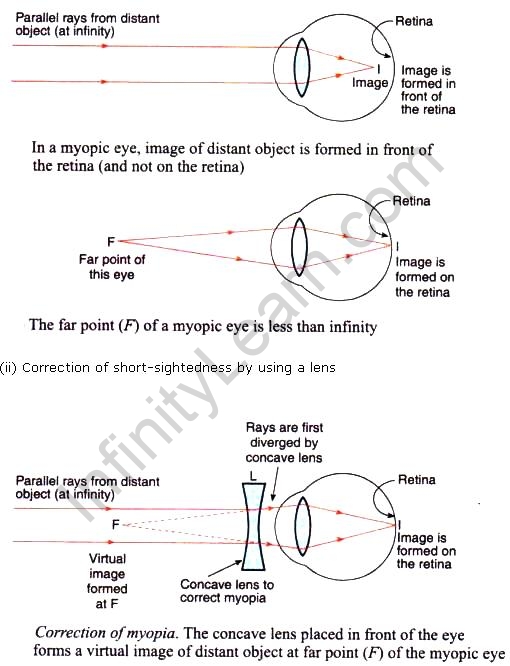
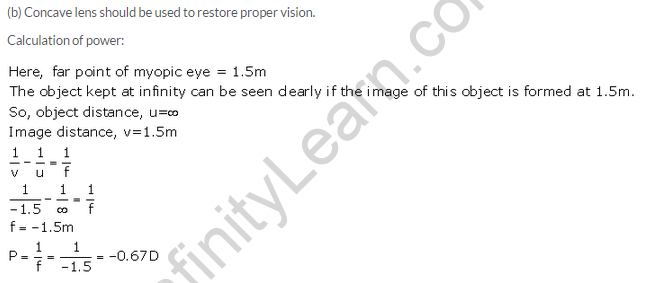
Question 34:
(a) What is long-sightedness ? State the two causes of long-sightedness (or hypermetropia). With the help of ray diagrams, show :
- the eye-defect long-sightedness.
- correction of long-sightedness by using a lens.
(b) An eye has a near point distance of 0.75 m. What sort of lens in spectacles would be needed to reduce the near point distance to 0.25 m ? Also calculate the power of lens required. Is this eye long-sighted or shortsighted ?
(c) An eye has a far point of 2 m. What type of lens in spectacles would be needed to increase the far point to infinity ? Also calculate the power of lens required. Is this eye long-sighted or short-sighted ?
Solution :
(a) Long-sightedness is a vision impairment in which a person can see far objects clearly but cannot see nearby ones properly.
Causes:
1. The eye lens’ focal length is excessively lengthy.
2. The eyeball has shrunk in size.
Ray diagram for:
(i) eye-defect long-sightedness
Question 47:
In a certain murder investigation, it was important to discover whether the victim was long-sighted or short-sighted. How could a detective decide by examining his spectacles ?
Solution :
The person was long sighted if the spectacle lenses were convex, and short sighted if the spectacle lenses were concave.
Question 48:
The picture given here shows a person wearing ‘half-moon’ spectacles. What sort of eye-defect do you think he has ? Why are these particular spectacles useful to him ?
Solution :
Reading glasses with a half moon shape are worn. As a result, the individual has long-sightedness.
The convex lenses of spectacles form a picture of a nearby object (such as a book in hand) at the near point of his eye, which is advantageous to him.
Question 49:
A short-sighted person has a near point of 15 cm and a far point of 40 cm.
(a) Can he see clearly an object at a distance of:
(i) 5 cm ? (ii) 25 cm ? (iii) 50 cm ?
(b) To see clearly an object at infinity, what kind of spectacle lenses does he need ?
Solution :
(a) (i) No, (ii) Yes, (iii) No
(b) Concave lenses
Question 50:
The near point of a long-sighted person is 50 cm from the eye.The near point of a long-sighted person is 50 cm from the eye.
(a) Can she see clearly an object at :
(i) a distance of 20 cm ?
(ii) at infinity ?
(b) To read a book held at a distance of 25 cm, will she need converging or diverging spectacle lenses ?
Solution :
(a) (i) No, (ii) Yes
(b) Converging lenses
Question 51:
A person can read a book clearly only if he holds it at an arm’s length from him. Name the defect of vision :
(a) if the person is an old man
(b) if the person is a young man
Solution :
(a) Presbyopia
(b) Hypermetropia
Question 1:
How much is our field of view :
(a) with one eye open ?
(b) with both eyes open ?
Solution :
(a) About 150o
(b) About 180o
Question 2:
Which of the following have a wider field of view ?
(a) Animals having two eyes on the opposite sides of their head.
(b) Animals having two eyes at the front of their head.
Solution :
Animals having two eyes on the opposite sides of their head.
Question 3:
Out of animals of prey and predators, which have their eyes :
- at the front of their head ?
- on the opposite sides of their head ?
Solution :
- Predators
- Animals of prey
Question 4:
State whether the following statement is true or false :
Rabbit has eyes which look sideways.
Solution :
True
Question 5:
Fill in the following blanks with suitable words :
(a) Having two eyes gives a…………. field of view.
(b) Having two eyes enables us to judge………….. more accurately.
Solution :
(a) wider
(b) distances
Question 6:
What are the advantages of having two eyes instead of just one ?
Solution :
Following are the advantages of having two eyes instead of one:
1. Having two eyes gives a wider field of view.
2. Having two eyes enables us to judge distances more accurately.
Question 7:
Explain clearly why, a person who has lost the sight of one eye is at a disadvantage compared with the normal person who has two good eyes.
Solution :
A person who has lost one eye’s vision has a narrower field of view than someone who has two healthy eyes. Furthermore, a person who only has one eye is unable to discern distances effectively.
Question 8:
Name two animals having eyes :
(a) on the sides of the head.
(b) at the front of the head.
Solution :
(a) Rabbit, deer
(b) Tiger, lion
Question 9:
Among animals, the predators (like lions) have their eyes facing forward at the front of their heads, whereas the animals of prey (like rabbit) usually have eyes at the sides of their head. Why is this so ?
Solution :
Predators (such as lions) have their eyes in the front of their heads, but prey species (such as rabbits) have their eyes on the sides of their heads, allowing them to see their foes (predators) in a vast area around them and attempt to flee.
Question 10:
Five persons A, B, C, D and E have diabetes, leukaemia, asthma, meningitis and hepatitis, respectively.
(a) Which of these persons can donate eyes ?
(b) Which of these persons cannot donate eyes ?
Solution :
(a) A and C
(b) B, D and E
Question 1:
As light rays pass from air into a glass prism, are they refracted towards or away from the normal ?
Solution :
Towards the normal
Question 2:
As light rays emerge from a glass prism into air, are they refracted towards or away from the normal ?
Solution :
Away from the normal
Question 3:
Name a natural phenomenon which is caused by the dispersion of sunlight in the sky.
Solution :
Rainbow
Question 4:
What information do we get about sunlight from the formation of a rainbow ?
Solution :
Sunlight consists of seven colours.
Question 5:
What did Newton demonstrate by his experiments with the prism ?
Solution :
Newton demonstrated by his experiments with the prisms that white light consists of a mixture of seven colours.
Question 6:
What colours make up white light ?
Solution :
Seven colours – Violet, indigo, blue, green, yellow, orange, red
Question 7:
Give the meaning of the term VIBGYOR. With which phenomenon is it connected ?
Solution :
The phrase VIBGYOR denotes the seven colours of the white light spectrum, with V standing for Violet, I for Indigo, B for Blue, G for Green, Y for Yellow, O for Orange, and R for Red.
It has to do with the phenomenon of light dispersion.
Question 8:
In the formation of spectrum of white light by a prism :
- which colour is deviated least ?
- which colour is deviated most ?
Solution :
- Red
- Violet
Question 9:
What colours lie on the two sides of the ‘green colour’ in the spectrum of white light ?
Solution :
Yellow and Blue
Question 10:
Name the scientist who discovered that sunlight consists of seven colours.
Solution :
Newton
Question 11:
What is the order of colours in a rainbow, from the outside to the inside ?
Solution :
Red, Orange, Yellow, Green, Blue, Indigo and Violet
Question 12:
Which colour of the spectrum has (a) longest wavelength, and (b) shortest wavelength ?
Solution :
(a) Red
(b) Violet
Question 13:
Which light has the longer wavelength : red light or blue light ?
Solution :
Red Light
Question 14:
Which colour of light has the shorter wavelength – red or violet ?
Solution :
Violet
Question 15:
Fill in the blanks with suitable words :
(a) When a ray of light enters a prism, it bends…………. ..the normal; as it leaves the prism, it bends…………..
the normal.
(b) White light is composed of…………I The colour of white light deviated through the largest angle by
a prism is………..
Solution :
(a) towards, away from
(b) seven, violet
Question 16:
- A ray of white light breaks up into its components while passing through a glass prism.
Draw a ray diagram to show the path of rays. - Mark the least deviated colour in your diagram.
- Why do different coloured rays deviate differently in a prism ?
Solution :
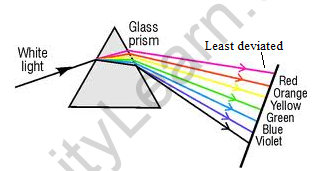
3. Different coloured rays deviate differently in a prism because different colours travel at different speeds through the glass prism.
Question 17:
(a) What happens when a ray of ordinary light is passed through a triangular glass prism ?
(b) What will happen if another similar glass prism is placed upside down behind the first prism ?
Solution :
(a) Ordinary light divides into a band of seven colours when it passes through a triangular glass prism.
(b) If a second comparable glass prism is placed upside down behind the first, the seven coloured rays incident on the second prism merge to form the original white beam.
Question 18:
When a beam of white light is passed through a prism, it splits to form lights of seven colours. Is it possible to recombine the lights of seven colours to obtain the white light again ? Explain your answer.
Solution :
Yes, by arranging another comparable prism alongside the first one in the inverted position as shown below, you can recombine the lights of seven colours to generate white light.
The first prism splits white light into seven different coloured rays. The second prism collects all seven coloured photons from the first prism and recombines them into white light. This is due to the fact that the second prism’s refrration is equal to and opposite that of the first prism.
Question 19:
(a) What is spectrum ? What is the name of glass shape used to produce a spectrum ?
(b) How many colours are there in a full spectrum of white light ? Write the various colours of spectrum in the order, starting with red.
Solution :
(a) A spectrum of white light is a band of seven colours created on a white screen when a beam of white light passes through a glass prism. A spectrum is created using a glass prism.
(b) The spectrum of white light has seven colours. Red, Orange, Yellow, Green, Blue, Indigo, and Violet are the colours.
Question 20:
What is meant by dispersion of white light ? Describe the formation of rainbow in the sky with the help of a diagram.
Solution :

Question 21:
In the figure given alongside, a narrow beam of white light is shown to pass through a triangular glass prism. After passing through the prism, it produces a spectrum YX on the screen.
(a)State the colour seen (i) at X, and (ii) at Y.
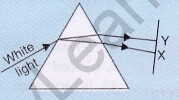
(b) Why do different colours of white light bend through different angles with respect to the incident beam of light ?
Solution :
(a) (i) violet (ii) Red
(b) Different colours of white light bend through different angles because different colours travel through different speeds through in the glass prism.
Question 22:
Draw a diagram to show how white light can be dispersed into a spectrum by using a glass prism. Mark the various colours of the spectrum.
Solution :
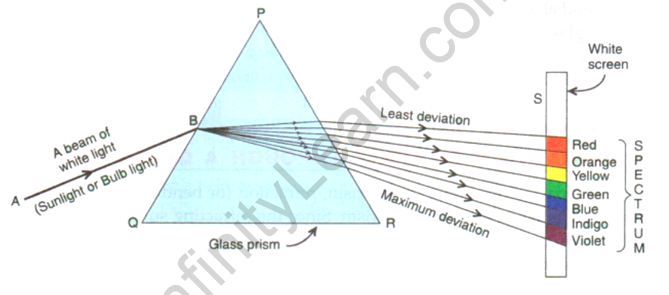
Question 23:
Make two diagrams to explain refraction and dispersion.
Solution :
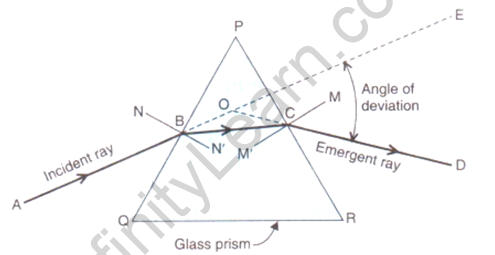
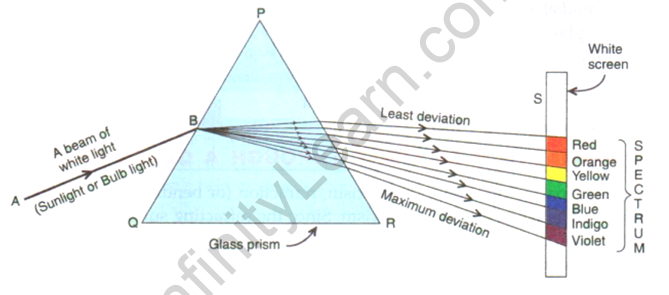
Question 24:
Describe how you could demonstrate that white light is composed of a number of colours.
Solution :
A white light beam will be allowed to pass through a glass prism. The white light breaks into seven different colours. This demonstrates that white light is made up of seven different colours.
Question 25:
How could you show that the colours of the spectrum combine to give white light ?
Solution :
The colours of a spectrum from one prism are allowed to fall on a comparable prism, but inverted, placed adjacent to the first prism. The second prism produces a refraction that is equal to and opposite to that of the first prism. As a result, the spectrum’s colours merge to produce white light.
Question 26:
Which is refracted most by a prism : red light or violet light ? Explain why ?
Solution :
Violet light is refracted the most because violet colour has the minimum speed in glass prism.
Question 27:
(a)Draw a diagram to show the refraction of light through a glass prism. On this diagram, mark
- incident ray
- emergent ray, and
- angle of deviation.
(b) What is a rainbow ? What are the two conditions necessary for the formation of a rainbow in the sky ?
(c) What acts as tiny prisms in the formation of a rainbow ?
(d) Name the process which is involved in the formation of a rainbow.
(e) What are the seven colours seen in a rainbow ?
Solution :

(b) A rainbow is a seven-colored arch visible in the sky caused by the scattering of the sun’s light by droplets in the atmosphere. When the sun shines and it rains at the same moment, a rainbow appears in the sky.
(c) Raindrops
(d) Dispersion of light
(e) Red, Orange, Yellow, Green, Blue, Indigo and Violet.
Question 38:
Why do you not see a spectrum of colours when light passes through a flat pane of glass ?
Solution :
Because a flat pane of glass has parallel sides.
Question 39:
Name some everyday objects :
(a) which reflect all the colours in sunlight
(b) which absorb all the colours in sunlight
Solution :
(a) White Paper
(b) Blackboard
Question 40:
Where in nature can you find evidence that white sunlight may be made of different colours ?
Solution :
Formation of the rainbow in the sky
Question 1:
Name the phenomenon which causes the twinkling of stars.
Solution :
Atmospheric refraction of light
Question 2:
Name two effects produced by the atmospheric refraction.
Solution :
Twinkling of stars; Advance sunrise and delayed sunset
Question 3:
Which phenomenon makes us see the sun :
(a) a few minutes before actual sunrise ?
(b) a few minutes after actual sunset ?
Solution :
(a) Atmospheric refraction of sunlight
(b) Atmospheric refraction of sunlight
Question 4:
Atmospheric refraction causes advance sunrise and delayed sunset. By how much time is :
(a) sunrise advanced ?
(b) sunset delayed ?
Solution :
(a) About 2 minutes
(b) About 2 minutes
Question 5:
State whether the following statement is true or false :
The planets twinkle at night due to atmospheric refraction of light.
Solution :
False
Question 6:
Name the phenomenon due to which the stars seem higher in the sky than they actually are.
Solution :
Atmospheric refraction of light
Question 7:
Fill in the following blanks with suitable words :
We can see the sun about……….. minutes before the actual sunrise and about…………. minutes after the actual
sunset because of atmospheric…………..
Solution :
two, two, refraction
Question 8:
Why do stars seem higher than they actually are ? Illustrate your answer with the help of a diagram.
Solution :
Because of atmospheric refraction, light from the star appears to be higher than it actually is when it passes through the heavier layers of the earth’s atmosphere.
Question 9:
Explain why, the sun can be seen about two minutes before actual sunrise. Draw a diagram to illustrate your answer.
Solution :
Because of air refraction of the sun’s light, the sun can be seen about two minutes before real sunrise, as indicated in the diagram below. When the sun is just below the horizon, the light from less dense air to more dense air is refracted downwards as it passes through the atmosphere, giving the impression that the sun is raised over the horizon.
Question 10:
Explain why, if we look at objects through the hot air over a fire, the objects appear to be moving (or shaking) slightly.
Solution :
The air directly above the fire heats up. Because the hotter air is optically rarer, but the colder air higher up is optically denser, when we observe objects through hot and cold air layers with variable optical densities, refraction of light occurs at random, giving the impression that the objects are moving somewhat.
Question 11:
(a) What is atmospheric refraction ? What causes atmospheric refraction ?
(b) Why do stars twinkle on a clear night ?
(c) Explain why, the planets do not twinkle at night.
Solution :
(a) Atmospheric refraction is the refraction of light induced by the earth’s atmosphere. The varied optical densities of different layers of the earth’s atmosphere create it.
(b) Atmospheric refraction occurs when light from a star passes through different optical densities of air at different altitudes. The star’s light is refracted differently by the constantly shifting environment from one second to the next. As a result, the amount of starlight reaching our eyes fluctuates, giving the impression that the star is twinkling.
(c) Planets look to us to be quite massive and can be thought of as a collection of a large number of light point sources. Some of the point sources’ dimming effects are cancelled out by the brighter effects of other point sources. As a result, the total brightness remains constant, and the planets do not twinkle.
Question 20:
We know that light refracts (or bends) when it goes from one medium to another. Now, the atmosphere contains only air. Then how does light get refracted on passing through only air in the atmosphere ?
Solution :
The atmosphere is made up entirely of air, but not all of it is at the same temperature. Some of the air layers are quite chilly, while others are quite warm. The atmosphere’s cooler air layers act as an optically denser medium for light rays, while the warmer air layers act as an optically rarer medium. As a result, when light passes through these layers of air in the atmosphere, it is refracted.
Question 21:
By how much time the day would have been shorter if the earth had no atmosphere ?
Solution :
By about 4 minutes
Question 22:
A student claims that because of atmospheric refraction, the sun can be seen after it has set, and the day is, therefore, longer than if the earth had no atmosphere.
(a) What does the student mean by saying that the sun can be seen after it has set ?
(b) Do you think that the students’ conclusion is correct ?
Solution :
(a) This means that we can see the sun for around two minutes after it has set due to atmospheric refraction. If the earth didn’t have an atmosphere, such atmospheric refraction would not have been feasible. As a result of the earth’s atmosphere, the day is longer.
(b) Yes
Question 1:
What is the colour of the sunlight :
(a) scattered by the dust particles in the atmosphere ?
(b) scattered by the air molecules in the atmosphere ?
Solution :
(a) White
(b) Blue
Question 2:
Which of the two is scattered more easily : light of shorter wavelengths or light of longer wavelengths ?
Solution :
Light of shorter wavelengths
Question 3:
State whether the following statements are true or false :
(a) The scattering away of red light makes the sky appear blue during the day time.
(b) The scattering away of blue light makes the sun appear red at sunset.
Solution :
(a) False
(b) True
Question 4:
What colour does the sky appear to an astronaut ?
Solution :
Dark or black
Question 5:
Which effect is illustrated by the observation that when a beam of sunlight enters a dusty room, then its
path becomes visible to us.
Solution :
Tyndall effect
Question 6:
State two effects produced by the scattering of light by the atmosphere.
Solution :
Two effects produced by the scattering of light by the atmosphere are:
-Sky appears blue.
-Sun appears red at sunrise and sunset.
Question 7:
What is tyndall effect ? Explain with an example
Solution :
The Tyndall effect is the dispersion of light by particles in its passage.
When a ray of sunlight enters a dusty room through a window, the light is scattered by the dust particles in the air, and its path becomes apparent to us.
Question 8:
What happens when a beam of sunlight enters a dusty room through a window ? Explain your answer.
Solution :.
When a beam of sunlight enters a dusty room through a window, then its path become visible to us. The tiny dust particles present in the air of room scatter the beam of light all around the room.
Question 9:
Why does the sky appear blue on a clear day ?
Solution :
The sky appears blue on a clear day because the blue component of white sunlight is dispersed by air molecules in the atmosphere. When sunlight passes through the atmosphere, the longer wavelength light is largely unaffected and hence flows right through. The shorter wavelength blue light, on the other hand, is dispersed over the sky, and some of this scattered blue light reaches our eyes from every angle.
Question 10:
Why does the sky appear dark (or black) to an astronaut instead of blue ?
Solution :
Because there is no atmosphere in deep space to scatter sunlight, the sky appears gloomy and black to an astronaut instead of blue. As a result of the lack of diffused light reaching our eyes in deep space, the sky seems dark and black.
Question 11:
Why does the sun appear red at sunrise ?
Solution :
At sunrise, the sun and surrounding sky seem red because much of the blue colour in sunlight has been scattered out and away from our line of sight, leaving mostly red colour in the direct sunlight beam that reaches our eyes.
Question 12:
Why does the sun appear red at sunset ?
Solution :
At sunset, the sun and surrounding sky seem red because much of the blue colour in sunlight has been scattered out and away from our line of sight, leaving mostly red colour in the direct sunlight beam that reaches our eyes.
Question 13:
Why are the ‘danger signal’ lights red in colour ?
Solution :
‘Danger’ signls are red in colour because the red coloured light having longer wavelength is the least scattered by fog or smoke particles. Due to this the red light can be seen in the same colour even from a distance.
Question 14:
(a) Draw a neat and labelled diagram of the experimental set up for observing the scattering of light in a colloidal solution of sulphur to show how the sky appears blue, and the sun appears red at sunrise and sunset.
(b) Out of blue light and red light, which one is scattered more easily ?
(c) Which component of sunlight is scattered away when the sun appears red at sunrise or sunset ?
(d) What causes the scattering of blue component of sunlight in the atmosphere ?
Solution :
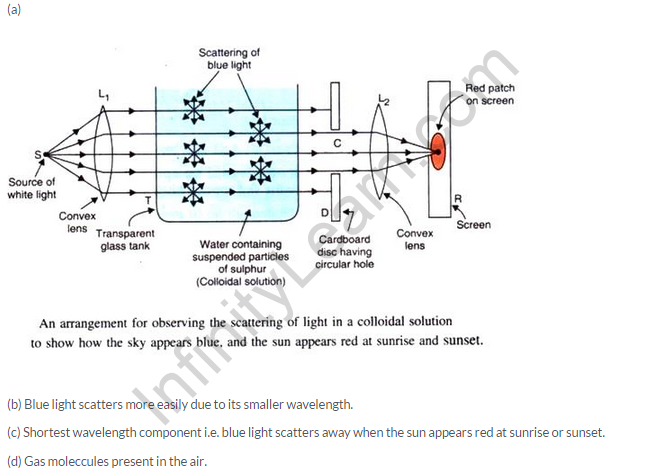
Question 20:
In an experiment to study the scattering of light by passing a beam of white light through a colloidal solution of sulphur in a transparent glass tank :
(a) Which colour is observed from the front of the glass tank ? Does this colour correspond to the colour of
sky on a clear day or the colour of sky around the sun at sunset ?
(b) Which colour is observed from the sides of the glass tank ? Does this colour correspond to the colour of
sky on a clear day or the colour of sky around the sun at sunset ?
Solution :
(a) Red colour is observed from the front of the glass tank. This colour corresponds to the colour of sky around the sun at sunset.
(b) Blue colour is observed from the sides of the glass tank. This colour corresponds to the colour of sky on a clear day.
Question 21:
Explain why, when the sun is overhead at noon, it appears white, but when the same sun is near the horizon at sunset, it appears red.
Solution :
When the sun is directly overhead, the light it emits must travel a shorter distance through the atmosphere to reach us. Only a small amount of the blue tint of the white light is scattered during the shorter voyage of sunshine. Because the light from the overhead sun has nearly all of its component colours in the correct proportions, the sun in the sky seems white to us.
When the sun is close to the horizon at sunset, however, the light must travel the maximum distance through the atmosphere to reach us. The majority of the shorter wavelength blue colour present in sunlight is scattered out and away from our line of sight throughout its long journey. So, the light reaching us directly from the setting sun consists mainly of longer wavelength red colour due to which the sun appears red.
Question 22:
Complete the following statements :
When the sun is setting, the light from it has to travel a ……………… thickness of the earth’s atmosphere and
only…….. wavelength……… light is able to reach us. Sunset is therefore……….
Solution :
greater; longer; red; red


